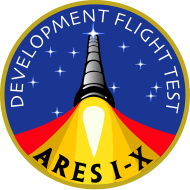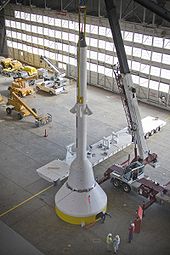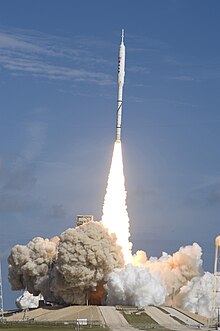Ares IX
| Mission emblem | |||
|---|---|---|---|

|
|||
| Mission dates | |||
| Mission: | Ares IX | ||
| Dimensions: | 816 t | ||
| Launcher: | Ares I (1st level only) | ||
| Begin: | October 28, 2009 at 15:30 UTC | ||
| Starting place: | Kennedy Space Center LC-39B | ||
| Landing: | |||
| Landing place: | Atlantic Ocean | ||
| Flight duration: | 6 min 30 sec | ||
| Earth orbits: | suborbital | ||
| Apogee : | 50 km | ||
| Covered track: | 230 km | ||
| ◄ Before / After ► | |||
|
|||
Ares IX was the name given to the first test flight of a Ares rocket as part of discontinued Constellation program of NASA . The main aim of the flight was to validate the control software for Ares I and to check important flight characteristics of the rocket, especially the first stage. In addition, it was possible to practice and test the processes during assembly, start preparations and rescue. The launch took place on October 28, 2009.
Structure of the missile
Ares IX was a two-stage rocket with a height of 99.67 m and a launch mass of 816 t.
The first stage consisted of a space shuttle- derived solids booster with four active segments and one inactive segment and was provided by Alliant Techsystems (ATK). The inactive segment included the first-stage flight computer , developed by Jacobs Engineering and Lockheed Martin , and the hydrazine- powered auxiliary power generation ( APU ) control for thrust vector control . Small additional solid matter motors controlled the separation process from the second stage. The large Z, which was painted black on the outside, was used for visual control of the rocket's roll and wobble.
In the final version of the Ares-I rocket, five active elements (as opposed to four in the space shuttle) would have provided the necessary launch boost.
The second stage was developed by NASA's Glenn Research Center and consisted of mass simulators for the upper stage, service and command module. The upper level contained another flight computer, which evaluated the flight data and sent it to the ground station, as well as the Roll Control System (RoCS) from Teledyne Brown Engineering operated with dinitrogen tetroxide and monomethylhydrazine . It consisted of two small engines from the former Peacekeeper rocket program, the nozzles of which were arranged tangentially and controlled the roll movement of the rocket during launch and during flight by firing at right angles to the longitudinal axis . Inside the upper stage dummy, adjustable steel plates were also attached as ballast.
Teams from the United Space Alliance , ATK and Cape Canaveral Air Force Station were responsible for the launch and flight monitoring .
Preparations

Preparations for the flight began with the preliminary deactivation of launch system 39B for shuttle operations on January 1, 2007, so that the launch system could be modified as much as possible for Ares I flights before the platform could be used one last time for a possible shuttle flight ( STS-400 ) was used. Highbay 3 of the Vehicle Assembly Building has already been modified and can build Ares-I missiles. Only the mobile launch platform 1 (MLP-1) was still occupied by the space shuttle program at that time.
The first component of the rocket, part of the solids booster, arrived at the Kennedy Space Center on November 10, 2008 . Like the shuttle boosters, it was brought to the Kennedy Space Center by train. Further components were delivered over the following weeks, including the simulators for the command module and the demolition system, which arrived at the end of January. The last component arrived at the end of March. The parts were stored in the Vehicle Assembly Building until they were assembled.
Mobile launch platform 1 (MLP-1) was transferred by the shuttle program on February 25, 2009 and rolled to launch system 39B so that the necessary modifications can be made. These mainly affect the computers that monitor the shuttle's systems on the platform. It was rolled into Highbay 3 a few days later so that assembly of the rocket could begin. At the beginning of June, the launch system was also transferred unrestrictedly by the shuttle program.
The assembly of the rocket was finished on August 14th and October 31st was given as the planned launch date. However, the start date was initially very uncertain, as the space shuttle Atlantis was already on the neighboring launch pad 39A on this date , in order to take off two weeks later for the STS-129 mission . At first it was not clear whether a possible failure of the Ares IX missile could affect the preparations for the Atlantis or even damage the shuttle. On September 22nd, the start date was brought forward three days to October 27th due to the successful course of the preparations and countdown tests. The rocket was driven to the launch pad on October 20 and declared ready to fly three days later during the readiness inspection.
Mission history
First attempt to start
The first attempt at launch was planned for October 27, 2009, but was not carried out. The main reason for this was the weather, which exceeded the limits laid down in the start rules several times during the entire four-hour start window. Most of the problems were caused by the rule about the permissible frictional charge . When the rocket ascends, static electricity can develop on its surface , which can interrupt communication with the ground stations. Since the Ares IX as a new spacecraft did not have a certificate against this threat, this criterion was so crucial. There were also further delays due to a cargo ship in the security zone and a pitot tube cover that was difficult to remove. In total, the start was postponed ten times at different intervals. One of the postponements was ordered just 28 minutes and 39 seconds before a possible start after the weather changed again after the four-minute final countdown restarted. Shortly after the countdown was canceled, it was decided to try again the next day.
Second take-off attempt and course of the flight
Due to the unstable weather conditions, the countdown to the second launch attempt on October 28, 2009 had to be postponed several times until the rocket could be successfully launched at 15:30 UTC . With a maximum acceleration of almost 2.5 g and a thrust of 11.6 MN, it reached a top speed of Mach 4.76 (about 5,800 km / h). The first stage burned out after 123 seconds; it was cut off at an altitude of about 40 km. Independently of each other, both stages drifted due to the remaining kinetic energy to an altitude of about 46 km and then fell back towards the Atlantic . A little later, the first stage parachute system was deployed to slow it down gradually. To reduce the opening shock, the main parachutes were initially partially opened, with one of the lines tearing several lines. So only two thirds of the braking effect was available and damage also occurred to the second glider when fully opened. As a result, only about half of the full braking effect was achieved in the final phase, so that due to the higher speed when hitting the water, a segment of the missile hull was damaged.
The second stage fell uncontrollably into the Atlantic as planned and was not recovered.
After the flight
Shortly after the flight, it was discovered that there had been damage to the hypergolic fuel lines at the launch system. A special team dispatched to the launch facility two hours after the watering later reported substantial heat damage to the entire structure. Both elevators were inoperable, the communication lines completely destroyed and some external loudspeakers melted beyond recognition, so that temporary solutions had to be used.
During the recovery of the first stage, the rescue divers recognized a kink in the rocket casing, from which it was concluded that the rocket hit the water surface at too high a speed and at an unfavorable angle. Only one of the three 45 m parachutes had opened fully. The step arrived back at the launch site on October 30th for further investigation in the tow of the rescue ship Freedom Star .
criticism
The relatively early test flight Ares IX was heavily criticized from various sides. Since the rocket only flew with four booster segments and not with five elements as it was later in use, the flight profile changed relatively significantly. The separation of the first stage took place, for example, at Ares IX at 39.6 kilometers instead of 57.1 kilometers, as in the later operational flight. As a result, some scientists fear that the data obtained will be worthless.
In addition, the software used for engine control did not correspond to the original, but was a modified version of the software used on the Atlas V. The control thrusters also did not correspond to the final version, on Ares IX control thrusters from Peacekeeper upper stages were used.
At times, too strong vibrations towards the end of the overrun phase were feared as a further problem. These could have posed a threat to the Ares IX's self-destruct system, which might not have worked due to the vibrations. Therefore, it was initially feared that the mission could not be given a launch permit.
NASA, however, reiterated the usefulness of the flight. The early test flight was carried out, among other things, in order to be able to use the measurement data to calibrate the computer programs used for the system design. The knowledge gained should flow into further development in good time. The expert commission set up by President Obama around Norman Augustine also supported the test flight. The Commission considered the flight to be useful even if the Ares program were to be halted.
Web links
- NASA: Ares Launch Vehicles
- Youtube: Ares 1x-V2.1 Test Flight Visualization of the flight process
- Youtube: Aerial View of Ares IX Flight Test Aerial photos of the flight process filmed from a Cessna Skymaster
- Parachute opening as seen by the on-board camera
- NASA: Ares IX Flight Test Vehicle (PDF; 406 kB)
Individual evidence
- ↑ a b NASASpaceflight.com: Ares IX undergoing ordnance installation - IX / STS-129 conflict evaluations , September 19, 2009 (English)
- ↑ Ares IX Launch Blog. NASA, October 28, 2009, accessed October 28, 2009 .
- ^ Ares IX at Launch Pad. NASA, October 20, 2009, accessed October 20, 2009 .
- ↑ Chris Bergin: Ares IX passes FTRR for Tuesday launch - weekend simulation set. NASASpaceflight.com, October 23, 2009, accessed October 26, 2009 .
- ^ John Mangels: Paint, static electricity, bending, and other pre-liftoff issues: Ares IX launch. CLEVELAND.COM, October 26, 2009, accessed November 9, 2009 .
- ↑ Stephen Clark: Parachute failure causes damage to Ares 1-X booster. NASASpaceflight.com, October 30, 2009, accessed October 31, 2009 .
- ↑ Chris Bergin: Pad 39B suffers substantial damage from Ares IX launch - Parachute update. NASASpaceflight.com, October 31, 2009, accessed October 31, 2009 .
- ↑ NASA: Ares IX Mission Specifications (PDF; 7.9 MB), accessed on September 17, 2009 (English)
- ↑ NASA: Ares I Crew Vehicle (PDF; 263 kB), accessed on September 17, 2009 (English)
- ↑ NASASpaceflight.com: Ares IX slips to September 18 as processing edges towards stacking , June 7, 2009 (English)
- ↑ a b NASASpaceflight.com: Chief Engineer outlines Ares IX issues - includes Thrust Oscillation , July 25, 2008 (English)



